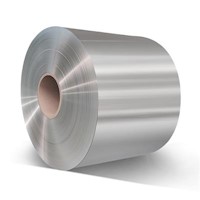| Items |

1100-0-020-36-C
Aluminum Sheet and Coil - Series 1100-0
|

1100-0-020-96
Aluminum Sheet and Coil - Series 1100-0
|

1100-0-025-36-C
Aluminum Sheet and Coil - Series 1100-0
|

1100-0-025-96
Aluminum Sheet and Coil - Series 1100-0
|

1100-0-032-36-C
Aluminum Sheet and Coil - Series 1100-0
|
|
Material
|
N/A
Aluminum
|
|
Shapeform
|
N/A
Coil
|
N/A
Sheets
|
N/A
Coil
|
N/A
Sheets
|
N/A
Coil
|
|
Series
|
N/A
1100-0
|
|
Grade
|
N/A
1100
|
|
Preparation
|
N/A
Paper Interleaved
|
|
Temper
|
N/A
Soft Temper
|
|
Finish
|
N/A
Mill
|
|
Thickness
|
N/A
0.02 inches0.508 mm
|
N/A
0.02 inches0.508 mm
|
N/A
0.025 inches0.6350 mm
|
N/A
0.025 inches0.6350 mm
|
N/A
0.032 inches0.8128 mm
|
|
Size
|
N/A
36 x Coil
|
N/A
36 x 96
|
N/A
36 x Coil
|
N/A
36 x 96
|
N/A
36 x Coil
|
|
Width
|
N/A
36
|
|
Length
|
N/A
|
N/A
96
|
N/A
|
N/A
96
|
N/A
|
|
Sheet Weight per Unit Area
|
N/A
0.282 lbs/ft²1.377 kg/m²
|
N/A
|
N/A
0.353 lbs/ft²1.723 kg/m²
|
N/A
|
N/A
0.452 lbs/ft²2.207 kg/m²
|
|
Weight per Sheet
|
N/A
|
N/A
6.77 lbs3.071 kg
|
N/A
|
N/A
8.47 lbs3.842 kg
|
N/A
|
|
Coil Weight per Length
|
N/A
0.847 lbs/ft1.260 kg/m
|
N/A
|
N/A
1.058 lbs/ft1.574 kg/m
|
N/A
|
N/A
1.355 lbs/ft2.016 kg/m
|
|
ASTM Specification
|
N/A
AMS 4001 AMS 4003 AMS-QQ-A-250/1 ASME SB-209 ASTM B209
|
|
Ultimate Strength
|
N/A
13 ksi
|
|
Yield Strength
|
N/A
5 ksi
|
|
Elongation percent in 2 inches
|
N/A
35
|
|
Hardness Brinnel Number
|
N/A
23
|
|
Ultimate Shearing Strength
|
N/A
9 ksi
|
|
Fatigue Endurance Limit1
|
N/A
5 ksi
|
|
Modulus of Elasticity2
|
N/A
10.0 x 106 ksi
|
|
Resistance to Corrosion - General3
|
N/A
A
|
|
Stress Corrosion Cracking4
|
N/A
A
|
|
Workability (Cold)5
|
N/A
A
|
|
Mechinability
|
N/A
E
|
|
Brazeability6
|
N/A
A
|
|
Gas Weldability7
|
N/A
A
|
|
Arc Weldability8
|
N/A
A
|
|
Resistance Spot and Seam Weldability9
|
N/A
B
|
|
Applications
|
N/A
Sheet metal work, spun hollowware, fin stock
|
|
Density
|
N/A
0.098 lbs/in³
|
|
Specific Gravity
|
N/A
2.71
|



